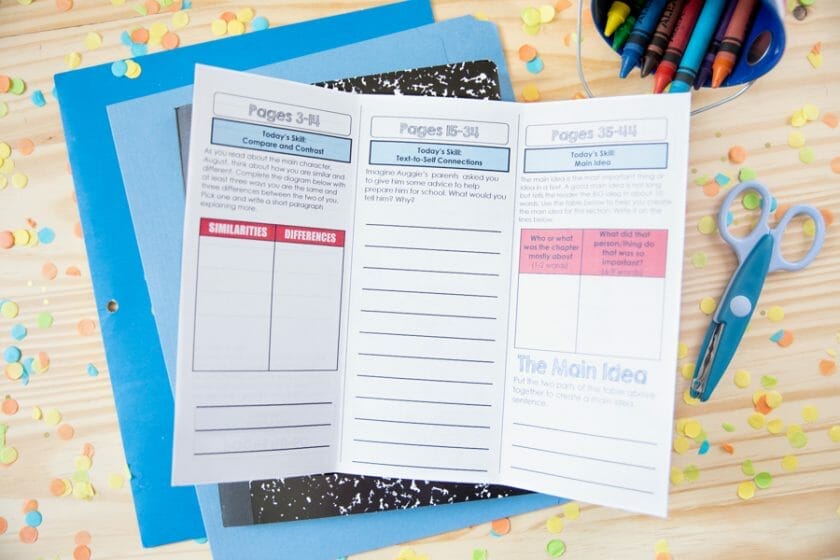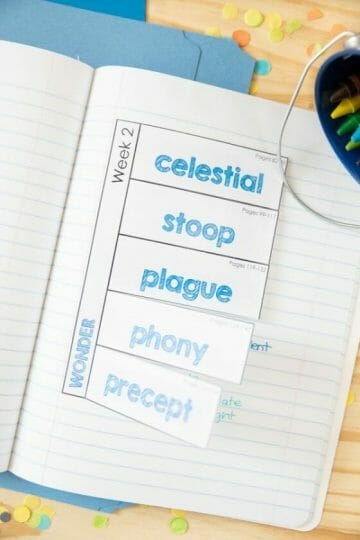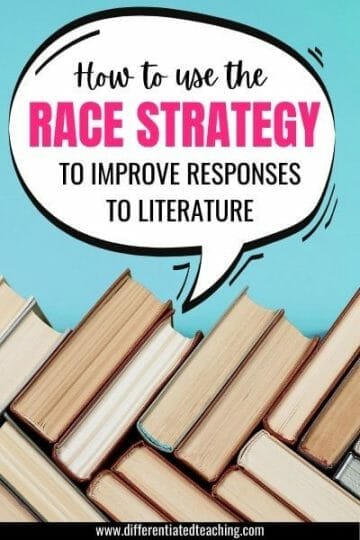Free & Inexpensive Ideas for Your Wonder Novel Study
Are you getting ready to dive into a Wonder novel study with your students? If you’re looking for engaging resources to bring R.J. Palacio’s inspiring story to life, you’ve come to the right place. Wonder has become a classroom favorite because of its powerful message about choosing kindness, a skill that’s essential for students to learn. This book is ideal for a whole-class novel study or a read-aloud for younger learners, and it works equally well as a book club or literature circle text for upper elementary and early middle school students.

In this post, I’ll share some of my favorite pre-reading activities, along with detailed Wonder literature study printables, and offer a few free post-reading activities that will leave a lasting impact on your students during your Wonder novel study.
I’ll also give you insights about the book to help you make the best choice for your readers. By the end of this post, you’ll have everything you need to create an unforgettable Wonder novel study that your students will cherish!
If you need a copy of the book, you can get Wonder in paperback on Amazon. (This link is an
Wonder Summary
This is the story of August Pullman, who’s been homeschooled his entire life due to some medical issues related to his craniofacial abnormalities. When Auggie turns 10, his family begins to realize that he needs to be able to function in a world where people aren’t always kind to those who look different. so they enroll him in school.
There are both ups and downs in this transition. As a fifth-grader at Beecher Prep, Auggie finds friendship and faces bullies. His friends are ostracized just for associating with him, which makes things even tougher.
The whole thing comes to a head when the 5th graders head to nature camp. When Auggie and Jack are attacked by some 7th graders looking for trouble, a few boys from their class come to their rescue and a fight ensues. Auggie is hurt and scared in the scuffle, but he’s also overwhelmed with emotion because the kids who have ignored him all this time stood up and protected him.
The only question is…will these changes be permanent?
What reading level is Wonder?
This book comes in at a whopping 320 pages. It is a Guided Reading Level V and has a Lexile score of 790L. Appropriate for fourth through sixth graders, the book is considered to be high-interest for students in grades 3-8.

Pre-Reading & Post-Reading Ideas for Wonder by R.J. Palacio
The pre-reading phase of your novel unit is a fantastic opportunity to spark students’ curiosity, ignite their imaginations, and build anticipation for the story. It’s also an ideal time to introduce key themes or big ideas you want them to focus on. That’s why choosing an engaging pre-reading activity is crucial for capturing students’ interest right from the beginning.
Here are some engaging activities that promise to captivate your learners and get students in the right frame of mind for your Wonder novel study.
- Kindness Chain Reaction: Brainstorm ways a single act of kindness can ripple outwards and impact others. Students can then draw a chain reaction depicting this concept. You can also start a Kindness Chain using this freebie.
- Looking Glass Self-Reflection: Have students create a “looking glass” with positive affirmations or images reflecting their strengths and inner beauty. This connects to the idea of looking beyond appearances, a central theme in Wonder.
- “Wonder-ful” Words: Create a word web centered on the word “wonder.” Students can add synonyms, antonyms, and words that evoke feelings of curiosity or amazement.
- Perfect Imperfections: Discuss the concept of perfection. Is it achievable? Does it matter? Have students create self-portraits that celebrate their unique qualities and “imperfections.”
- Quote Collage Inspiration: Present a collection of inspiring quotes about kindness, acceptance, and inner strength. Students can choose a quote that resonates with them and create a collage to visually represent it.
These pre-reading activities are crafted to spark curiosity around the themes of kindness, acceptance, and personal growth. Since different students connect with different aspects of a story—and you may want to tie in other subjects—I’ve included a variety of fun, hands-on options that are sure to engage your learners. These themes are at the heart of Wonder.
Meaningful Wonder Post-reading Activities
After finishing your novel study, it’s helpful to include a few activities to bring the experience to a meaningful close for students. These post-reading activities are designed to extend Wonder beyond the pages, giving students the chance to delve deeper into the story through hands-on projects, interactive challenges, and creative tasks that reinforce key concepts and connections.
- Choose Kind Campaign: Inspired by the precept “Choose Kind” from the book, brainstorm ways the class can spread kindness throughout the school or community. They can create posters, write messages of encouragement, or organize a service project.
- Augmented Auggie: Using a free drawing app, students can create an augmented reality version of Auggie, adding details about his interests and personality. This can be presented alongside a “normal” picture, highlighting his inner world.
- Wonder’s Wardrobe: Design a dream outfit for Auggie that reflects his personality and interests. Students can explain their choices in a short presentation.
- Precepts in Action: Revisit the five precepts mentioned in the book. Have students create a comic strip or short video depicting a situation where each precept is put into practice.
- “Wonder-ful” News Report: Students create a mock news report from the perspective of a character in the book, sharing their experiences and insights.
- Inclusion is an Art Project: Create a collaborative art project that celebrates diversity and inclusion. This could be a mural, a sculpture made from recycled materials, or a piece of performance art.
- Julian’s Journey Empathy Project: Write a letter from Julian’s perspective to Auggie, reflecting on their experiences and newfound friendship. This encourages empathy and understanding from a character who initially struggles with Auggie’s differences.
What’s included in this novel study unit?
This month-long Wonder novel study unit breaks this fabulous book into 20 sections. Each day’s work includes both comprehension activities and vocabulary. There are four weeks worth of daily lesson objectives and paper-saving printables included in this resource.
Here’s more about what you’ll find inside this Wonder Novel Study:
- Instructional guide with daily comprehension skill, objective, and key Tier 2 & text-based vocabulary
- Comprehension trifolds (provided in color and black & white)
- Reader’s notebook comprehension prompts (matching trifolds)
- Word of the Day text-based vocabulary flipbooks
- Vocabulary word wall cards
- Trifold answer keys for easy grading
- Enrichment Mini-Book with engaging projects & activities related to the text
Reading comprehension skills targeted
These novel study
Some of the comprehension skills addressed in this novel study include:
- Making inferences
- Drawing conclusions
- Describing character change
- Analyzing characters & setting
- Identifying the main idea
- Point of view
- Context clues and vocabulary
- Using descriptive language
- Summarizing
- Utilizing text evidence
The daily lessons target one comprehension skill. This lets students focus on quality rather than quantity when it comes to responding to literature. Unlike many novel studies with lists of questions that require students to regurgitate the text, this format makes sure your students understand and can apply their knowledge to Wonder and other texts they read.
The novel study format
Comprehension prompts are provided in two formats, selected to reduce copies while still offering materials for student use.
Here’s an overview of each of the comprehension response formats:
The trifold format was the original design for this novel study. Each foldable was designed to cover a week’s worth of comprehension using only one piece of paper. Students respond to a targeted question each day that focuses the day’s reading on the target comprehension skill.

From the student’s perspective, the benefit of the trifold is that it is extremely approachable. Each day’s work only takes up a third of the page, and this keeps reluctant writers from shutting down.
From the teacher’s perspective, it is easy to collect and grade. Many students use the trifold as a bookmark, helping prevent missing papers.
The Reader’s Notebook prompts are perfect for advanced students, who provide a more in-depth analysis, and struggling writers, who may need more space to write their response.
For advanced readers, the notebook prompts can be used to generate a longer, more detailed response to the daily prompt. This pushes the students to analyze and defend their answers.
However, the notebook prompts are also great for students with dyslexia, dysgraphia, and fine motor issues because they can be glued onto specialized paper or within a notebook to give students with large handwriting more room to respond.

Regardless of the format selected, the prompt is the same so you can easily have some students working on the trifolds while others use the notebook prompts.
What vocabulary is included in this novel study?
There are over 50 academic vocabulary words included in the instructional guide to help you with teaching Wonder by RJ Palacio. These include general academic vocabulary and skill-specific vocabulary.
It is crucial to teach academic vocabulary explicitly and within context. Struggling learners often lack the vocabulary essential to perform well in school and on standardized assessments, so this is an easy way to incorporate this into your regular instructional practices. Learn more about why academic vocabulary is important.
Here is a small sample of the academic vocabulary you’ll find included in this novel study:
- analyze
- identify
- generate
- examine
- support
- point of view
- plotline
- summarize
- theme
- narrator
In addition to the Tier 2 vocabulary, each day’s lesson includes a text-based vocabulary word that can be found within the day’s reading. These words can be taught using the included flipbook format. Designed with conserving copies in mind, the flipbooks require only a half-piece of paper per week. Some of the vocabulary words included in this literature guide are:
- euphoric
- attribution
- hypocrite
- taciturn
- geneticist
- precept

The Word of the Day Flip Book is designed for use in interactive reading journals. To use the flipbooks, cut around the outer edge, cut the tabs, and glue it into their notebook. Have students leave the flaps unglued so they can be lifted. This allows students to write under them.

Depending on your students, you can have them generate a definition of the day’s word or generate a list of synonyms and antonyms. You can even have students draw a picture of the meaning.
Purchase this Wonder Novel Study
When you purchase the Wonder Novel Study PDF from Differentiated Teaching, you’ll receive all the following resources in a downloadable format:

- Daily comprehension prompts in 3 formats for differentiation
- Foldable trifold brochures
- Cut & paste journal prompts for interactive notebooks
- Daily Google Slides
- Weekly word of the day flip books for text-based vocabulary
- Post-reading activities booklet
- Vocabulary word wall cards
- Easy-to-follow directions for printing & prep
- Instructional planning guide
- Answer keys









